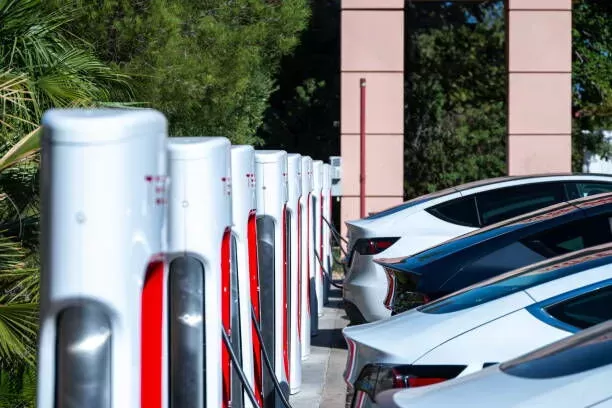Notifications

7 minutes, 27 seconds
-0 Views 0 Comments 0 Likes 0 Reviews

Charging Ahead into the Future
As electric vehicles (EVs) continue to gain momentum across global markets, the demand for faster, more reliable charging infrastructure has never been greater. Leading this transformation is ultrafast DC EV charging, also known as high-power charging (HPC)—a revolutionary advancement that delivers exceptional power output, drastically reduces charging times, and redefines the EV ownership experience.
With power levels typically ranging from 150 kW to 600 kW, ultrafast DC chargers can replenish an EV’s battery to 80% in as little as 10 to 30 minutes. But this innovation isn't just about speed—it’s about reshaping the practicality, scalability, and perception of electric mobility.
To fully appreciate the significance of ultrafast DC charging, it’s essential to understand the underlying technology: direct current (DC) fast charging.
Unlike traditional alternating current (AC) chargers (Level 1 and Level 2), DC chargers bypass the vehicle’s onboard inverter and deliver electricity directly to the battery. This results in significantly higher charging speeds and energy efficiency.
| Feature | AC Charging | DC Charging |
|---|---|---|
| Power Source | Alternating Current (120–240V) | Direct Current (400–1000V) |
| Conversion | In-vehicle (AC to DC) | External (DC fed directly to battery) |
| Charging Speed | Slow to moderate | Fast to ultra-fast |
| Common Use Cases | Homes, workplaces | Highways, fleet depots, commercial hubs |
Level 1 Charging (Standard)
Voltage: 120V
Speed: Adds 3–5 miles of range per hour
Use: Home charging via standard wall outlets
Level 2 Charging (Fast)
Voltage: 240V
Speed: Adds 15–30 miles per hour
Use: Residential, commercial, and workplace charging
Level 3 Charging (DC Fast / Ultrafast)
Voltage: 400V–1000V
Speed: Adds 100–200+ miles in 15–30 minutes
Use: Highways, fleet hubs, fast-charging networks
Ultrafast DC charging marks a transformative leap in EV technology and user convenience. While Level 1 and 2 chargers are suitable for routine charging, they fall short in fast-paced, high-demand scenarios.
Charging to 80% in under 15 minutes makes EV refueling nearly as fast as traditional gasoline. This convenience reduces friction for new adopters.
Strategic placement of ultrafast chargers along highways eliminates range anxiety, unlocking EV use for road trips and intercity travel.
For fleets, downtime equals lost revenue. Ultrafast chargers maximize vehicle availability and boost ROI for delivery, taxi, and public transit services.
Robust charging infrastructure inspires consumer confidence. Ultrafast stations are the backbone of a scalable, reliable EV ecosystem.
In dense urban environments, where home charging isn’t feasible, ultrafast chargers provide quick, efficient public charging without long wait times.
Ultrafast charging is made possible by a range of cutting-edge technologies:
High-voltage vehicle architecture (800V or more)
Liquid-cooled cables to safely handle large current loads
Smart charging protocols to optimize delivery speed and battery health
Advanced thermal management in both chargers and EV batteries
Leading standards include:
CCS (Combined Charging System)
CHAdeMO
Tesla Supercharger
Each supports high-speed, safe, and interoperable charging across compatible vehicle platforms.
While promising, ultrafast DC charging presents real-world challenges that must be addressed:
High power draw can stress local grids. Energy storage systems, load balancing, and renewable integration are essential for long-term sustainability.
Ultrafast stations require substantial investment: site prep, power upgrades, thermal systems, and advanced hardware. Costs will likely decline as deployment scales.
Many current EVs aren’t capable of handling ultra-high charging rates. Automakers are rapidly evolving, but standardization takes time.
Frequent ultrafast charging may degrade battery health. Solid-state batteries and adaptive charging algorithms aim to balance speed with longevity.
Governments and corporations are accelerating investments in high-power charging:
Europe: Leading with 350 kW chargers on major corridors (e.g., Ionity, Topper)
United States: Expanding the NEVI (National Electric Vehicle Infrastructure) program across interstates
China: Building thousands of HPC stations for the world’s largest EV fleet
Market Forecast: The global ultrafast DC charging market is projected to surpass $25 billion by 2030, driven by policy support, consumer demand, and innovation.
Integrating renewables with ultrafast charging stations offers environmental and economic benefits:
Battery energy storage systems (BESS) help manage peak loads and reduce grid dependency
Solar and wind power can charge BESS during off-peak hours for emission-free operation
Together, they enable sustainable and scalable fast-charging solutions
Emerging technologies set the stage for the next wave of charging infrastructure:
Wireless ultrafast charging: No cables, no hassle—just park and charge
AI-driven load management: Smarter energy allocation and reduced wait times
Vehicle-to-Grid (V2G) Integration: EVs as mobile energy storage for grid stabilization
Ultra-compact chargers: Sleek solutions for urban environments with limited space
Ultrafast DC charging is more than a technical achievement—it’s a cornerstone for mass EV adoption. It addresses key pain points like charging time, range anxiety, and infrastructure gaps.
For consumers: Unmatched convenience
For businesses: Operational efficiency
For cities: Cleaner air and carbon reduction
For governments: Alignment with net-zero targets
In the race to a zero-emission future, ultrafast charging isn't just keeping pace—it’s leading the charge.Know more about Google SEO Directory
China EV Chargers EV Charger Manufacturer EV Charging Solutions

